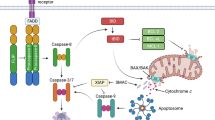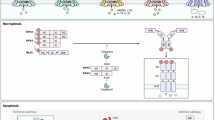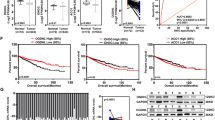Abstract
Subcellular organelles such as mitochondria, endoplasmic reticulum (ER) and the Golgi complex are involved in the progression of the cell death programme. We report here that soon after ligation of Fas (CD95/Apo1) in type II cells, elements of the Golgi complex intermix with mitochondria. This mixing follows centrifugal dispersal of secretory membranes and reflects a global alteration of membrane traffic. Activation of apical caspases is instrumental for promoting the dispersal of secretory organelles, since caspase inhibition blocks the outward movement of Golgi-related endomembranes and reduces their mixing with mitochondria. Caspase inhibition also blocks the FasL-induced secretion of intracellular proteases from lysosomal compartments, outlining a novel aspect of death receptor signalling via apical caspases. Thus, our work unveils that Fas ligand-mediated apoptosis induces scrambling of mitochondrial and secretory organelles via a global alteration of membrane traffic that is modulated by apical caspases.
Similar content being viewed by others
Log in or create a free account to read this content
Gain free access to this article, as well as selected content from this journal and more on nature.com
or
Abbreviations
- E64:
-
trans-epoxysuccinyl-L-leucylamido-(4-guanidino)butane
- HPA:
-
Helix pomatia agglutinin
- IETD:
-
benzyloxycarbonyl-Ile-Glu-Thr-Asp-fluoromethylketone
- IVM:
-
intensified video microscopy
- MTR:
-
Mitotracker®
- RB:
-
modified Ringer buffer
- TEM:
-
transmission electron microscopy
- z-VAD:
-
benzyloxycarbonyl-Val-Ala-Asp-fluoromethylketone
References
Peter ME, Krammer PH . The CD95(APO-1/Fas) DISC and beyond. Cell Death Differ 2003; 10: 26–35.
Chipuk JE, Green DR . Do inducers of apoptosis trigger caspase-independent cell death? Nat Rev Mol Cel Biol 2005; 6: 268–275.
Algeciras-Schimnich A, Shen L, Barnhart BC, Murmann AE, Burkhardt JK, Peter ME . Molecular ordering of the initial signaling events of CD95. Mol Cell Biol 2002; 22: 207–220.
Lee KH, Feig C, Tchikov V, Schickel R, Hallas C, Schutze S et al. The role of receptor internalization in CD95 signaling. EMBO J 2006; 25: 1009–1023.
Cristea IM, Degli Esposti M . Membrane lipids and cell death: an overview. Chem Phys Lipids 2004; 129: 133–160.
Levine B, Yuan J . Autophagy in cell death: an innocent convict? J Clin Invest 2005; 115: 2679–2688.
Di Sano F, Ferraro E, Tufi R, Achsel T, Piacentini M, Cecconi F . Endoplasmic reticulum stress induces apoptosis by an apoptosome-dependent but caspase 12-independent mechanism. J Biol Chem 2006; 281: 2693–2700.
Hicks SW, Machamer CE . Golgi structure in stress sensing and apoptosis. Biochim Biophys Acta 2005; 1744: 406–414.
Lowe M, Lane JD, Woodman PG, Allan VJ . Caspase-mediated cleavage of syntaxin 5 and giantin accompanies inhibition of secretory traffic during apoptosis. J Cell Sci 2004; 117: 1139–1150.
Hu W, Xu R, Zhang G, Jin J, Szulc ZM, Bielawski J et al. Golgi fragmentation is associated with ceramide-induced cellular effects. Mol Biol Cell 2005; 16: 1555–1567.
Maag RS, Mancini M, Rosen A, Machamer CE . Caspase-resistant golgin-160 disrupts apoptosis induced by secretory pathway stress and ligation of death receptors. Mol Biol Cell 2005; 16: 3019–3027.
Garcia-Ruiz C, Colell A, Morales A, Calvo M, Enrich C, Fernandez-Checa JC . Trafficking of ganglioside GD3 to mitochondria by tumor necrosis factor-alpha. J Biol Chem 2002; 277: 36443–36448.
Breckenridge DG, Stojanovic M, Marcellus RC, Shore G . Caspase cleavage product of BAP31 induces mitochondrial fission through endoplasmic reticulum calcium signals, enhancing cytochrome c release to the cytosol. J Cell Biol 2003; 160: 1115–1127.
Schneider-Brachert W, Tchikov V, Neumeyer J, Jakob M, Winoto-Morbach S, Held-Feindt J et al. Compartmentalization of TNF receptor 1 signaling: internalized TNF receptosomes as death signaling vesicles. Immunity 2004; 21: 415–428.
Sorice M, Circella A, Cristea IM, Garofalo T, Di Renzo L, Alessandri C et al. Cardiolipin and its metabolites move from mitochondria to other cellular membranes during death receptor-mediated apoptosis. Cell Death Differ 2004; 11: 1133–1145.
Sandra F, Degli Esposti M, Magnus M, Knight D, Ndebele K, Khosravi-Far R . TNF-related apoptosis inducing ligand (TRAIL) alters mitochondrial membrane lipids. Cancer Res 2005; 65: 1–12.
Hauri HP, Kappeler F, Andersson H, Appenzeller C . ERGIC-53 and traffic in the secretory pathway. J Cell Sci 2000; 113: 587–596.
Marra P, Maffucci T, Daniele T, Tullio GD, Ikehara Y, Chan EK et al. The GM130 and GRASP65 Golgi proteins cycle through and define a subdomain of the intermediate compartment. Nat Cell Biol 2001; 3: 1101–1113.
Kenis H, van Genderen H, Bennaghmouch A, Rinia HA, Frederik P, Narula J et al. Cell surface-expressed phosphatidylserine and annexin A5 open a novel portal of cell entry. J Biol Chem 2004; 279: 52623–52629.
Perez-Vilar J, Hidalgo J, Velasco A . Presence of terminal N-acetylgalactosamine residues in subregions of the endoplasmic reticulum is influenced by cell differentiation in culture. J Biol Chem 1991; 266: 23967–23976.
Bilyy RO, Stoika RS . Lectinocytochemical detection of apoptotic murine leukemia L1210 cells. Cytometry A 2003; 56: 89–95.
Eda S, Yamanaka M, Beppu M . Carbohydrate-mediated phagocytic recognition of early apoptotic cells undergoing transient capping of CD43 glycoprotein. J Biol Chem 2004; 279: 5967–5974.
Vetterlein M, Ellinger A, Neumuller J, Pavelka M . Golgi apparatus and TGN during endocytosis. Histochem Cell Biol 2002; 117: 143–150.
Kawasaki Y, Saito T, Shirota-Someya Y, Ikegami Y, Komano H, Lee MH et al. Cell death-associated translocation of plasma membrane components induced by CTL. J Immunol 2000; 164: 4641–4648.
Jaiswal JK, Andrews NW, Simon SM . Membrane proximal lysosomes are the major vesicles responsible for calcium-dependent exocytosis in nonsecretory cells. J Cell Biol 2002; 59: 625–635.
Azuma Y, Taniguchi A, Matsumoto K . Decrease in cell surface sialic acid in etoposide-treated Jurkat cells and the role of cell surface sialidase. Glycocnj J 2000; 17: 301–306.
Piller V, Piller F, Fukuda M . Biosynthesis of truncated O-glycans in the T cell line Jurkat. Localization of O-glycan initiation. J Biol Chem 1990; 265: 9264–9271.
Bell AW, Ward MA, Blackstock WP, Freeman HN, Choudhary JS, Lewis AP et al. Proteomics characterization of abundant Golgi membrane proteins. J Biol Chem 2001; 276: 5152–5165.
Schamel WW, Kuppig S, Becker B, Gimborn K, Hauri HP, Reth M . A high-molecular-weight complex of membrane proteins BAP29/BAP31 is involved inn the retention of membrane-bound IgD in the endoplasmic reticulum. Proc Natl Acad Sci USA 2003; 100: 9861–9866.
Szczesna-Skorupa E, Kemper B . BAP31 is involved in the retention of cytochrome P450 2C2 in the endoplasmic reticulum. J Biol Chem 2005; 281: 4142–4148.
Jones LJ, Upson RH, Haugland RP, Panchuk-Voloshina N, Zhou M, Haugland RP . Quenched BODIPY dye-labeled casein substrates for the assay of protease activity by different fluorescence measurement. Anal Biochem 1997; 251: 144–152.
Assfalg-Machleidt I, Rothe G, Klingel S, Banati R, Mangel WF, Valet G et al. Membrane permeable fluorogenic rhodamine substrates for selective determination of cathepsin L. Biol Chem Hoppe Seyler 1992; 373: 433–440.
Collette J, Bocock JP, Ahn K, Chapman RL, Godbold G, Yeyeodu S et al. Biosynthesis and alternate targeting of the lysosomal cysteine protease cathepsin L. Int Rev Cytol 2004; 241: 1–51.
Michallet MC, Saltel F, Flacher M, Revillard JP, Genestier L . Cathepsin-dependent apoptosis triggered by supraoptimal activation of T lymphocytes: a possible mechanism of high dose tolerance. J Immunol 2004; 172: 5405–5414.
Dadsetan S, Shishkin V, Fomina AF . Intracellular Ca2+ release triggers translocation of membrane marker fm1-43 from the extracellular leaflet of plasma membrane into endoplasmic reticulum in T lymphocytes. J Biol Chem 2006; 280: 16377–16382.
Falasca L, Bergamini A, Serafino A, Balabaud C, Dini L . Human Kupffer cell recognition and phagocytosis of apoptotic peripheral blood lymphocytes. Exp Cell Res 1996; 224: 152–162.
Matarrese P, Tinari A, Mormone E, Bianco GA, Toscano MA, Ascione B et al. Galectin-1 sensitizes resting human T lymphocytes to Fas (CD95)-mediated cell death via mitochondrial hyperpolarization, budding, and fission. J Biol Chem 2005; 280: 6969–6985.
Degli Esposti M, Cristea IM, Gaskell SJ, Nakao Y, Dive C . Pro-apoptotic Bid binds to monolysocardiolipin, a new molecular connection between mitochondrial membranes and cell death. Cell Death Differ 2003; 10: 1300–1309.
Acknowledgements
We thank the whole Bioimaging facility of the University of Manchester for the support provided and Martin Lowe and Saska Ivanova for their inputs. RK acknowledges Grant NIH/NHLBI (HL080192) and WM of grants from Ministero della Sanita'. MDE research is supported by BBSRC Grant BB/C508469.
Author information
Authors and Affiliations
Corresponding author
Additional information
Edited by G Salvesen
Rights and permissions
About this article
Cite this article
Ouasti, S., Matarrese, P., Paddon, R. et al. Death receptor ligation triggers membrane scrambling between Golgi and mitochondria. Cell Death Differ 14, 453–461 (2007). https://doi.org/10.1038/sj.cdd.4402043
Received:
Revised:
Accepted:
Published:
Issue date:
DOI: https://doi.org/10.1038/sj.cdd.4402043
Keywords
This article is cited by
-
Changes in membrane lipids drive increased endocytosis following Fas ligation
Apoptosis (2017)
-
Regulation of Golgi signaling and trafficking by the KDEL receptor
Histochemistry and Cell Biology (2013)
-
Caspase-mediated inhibition of sphingomyelin synthesis is involved in FasL-triggered cell death
Cell Death & Differentiation (2010)
-
Fas stimulation of T lymphocytes promotes rapid intercellular exchange of death signals via membrane nanotubes
Cell Research (2010)
-
Tumor necrosis factor (TNF)-related apoptosis-inducing ligand (TRAIL) induced mitochondrial pathway to apoptosis and caspase activation is potentiated by phospholipid scramblase-3
Apoptosis (2008)



